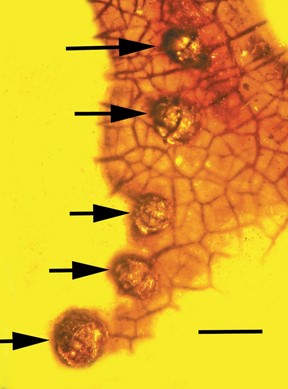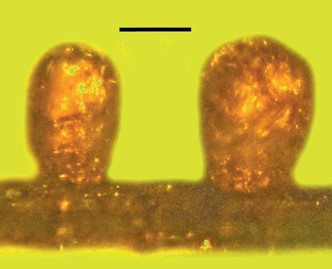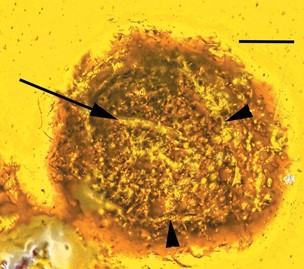Palaeomycus Poinar, gen. nov.
Index Fungorum number: MB 823323; Facesoffungi number: FoF
Type species: Palaeomycus epallelus gen. and sp. nov.
Diagnosis: Superficial fructifications (pycnidia) subtended by ramifying hyphae forming anastomosing networks. Pycnidia dark, sepa- rate, erumpent, carbonous, globose, uniloculate with a multicellular wall of aggregated cells, dehiscing by a wide cir- cular ostiole (Figures 1–3). Conidiophores simple or branched, closely appressed at base with exposed terminal portions bear- ing ovoid to ellipsoidal, hyaline, aseptate conidia (Figures 4–6).
Etymology: The generic name is derived from the Greek ‘palaios’ = old and the Greek ‘mykes’ = fungus.

Figure 1. Angiosperm leaf portion with dorsal view of 5 pycnidia (arrows) of Palaeomycus epallelus gen. and sp. nov. in Myanmar amber. Scale Bar = 822 µm.

Figure 2. Lateral view of two pycnidia of Palaeomycus epallelus gen. and sp. nov. in Myanmar amber. Scale Bar = 400 µm

Figure 3. Single pycnidium of Palaeomycus epallelus gen. and sp. nov. in Myanmar amber. Arrowheads show edge of ostiole. Arrow shows a small arthropod. Scale Bar = 190 µm.

Figure 4. Unbroken succession of conidiophores and conidia of Palaeomycus epallelus gen. and sp. nov. in Myanmar amber. Scale Bar = 23 µm.

Figure 5. Portion of a row of conidiophores bearing conidia of Palaeomycus epallelus gen. and sp. nov. in Myanmar amber. Arrowhead shows two-spored conidiophore. Scale Bar = 11 µm.

Figure 6. Portion of a row of conidiophores bearing conidia of Palaeomycus epallelus gen. and sp. nov. in Myanmar amber. Arrowhead shows a conidiophore with several branches, each bearing a conidium. Scale Bar = 9 µm.
Species
